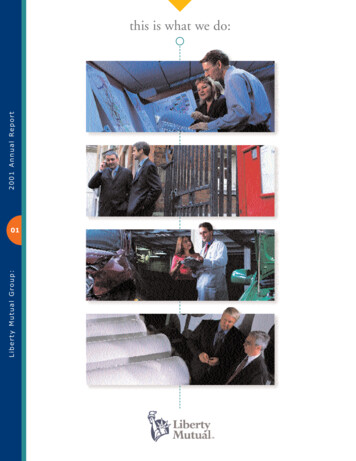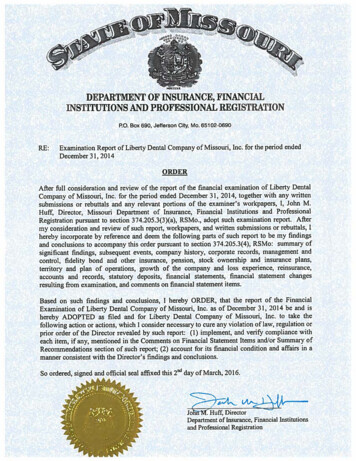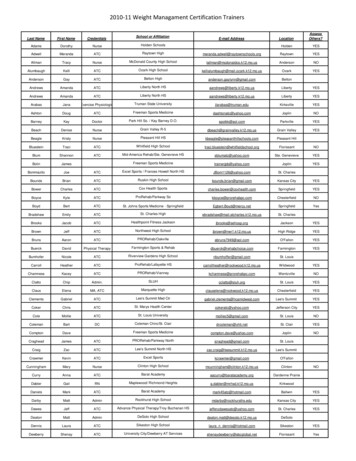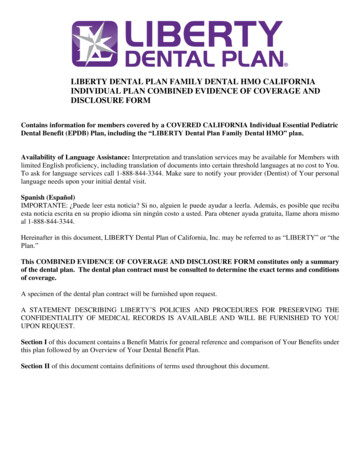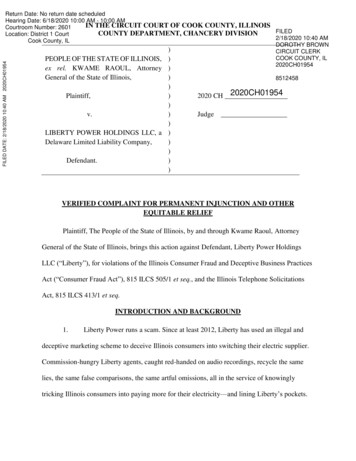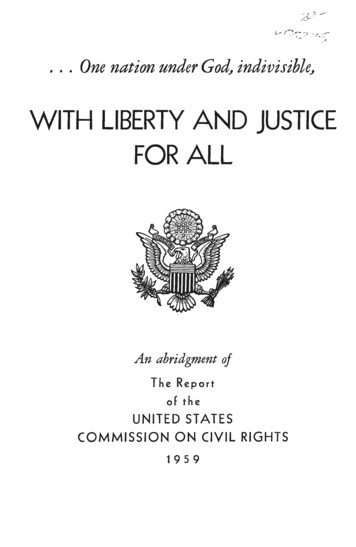
Transcription
y.Y/2 .z . . . One nation under God. indivisible. WITH LIBERTY AND JUSTICEFOR ALLAn ahridgment ofThe Reportof theUNITED STATESCOMMISSION ON CIVIL RIGHTS1959
MEMBERS OF THE COMMISSIONJOHN A. HANNAH, OhainnanROBERT G. STOREY, V ice OhairmanJOHN S. BATTLEDOYLE E. CARLTONREV. THEODORE M. HESB,U RGH, C.S.C.GEORGE M. JOHNSON STAFF DIRECTOR, GORDON M. TIFFANY succeeding J. Ernest Wilkins (D eceased).For sale by the Superintendent of Documents, U.S. Government Printing OfficeWashington 25, D .C. - Price 60 cents (paper cover)
PART TWOVOTINGCHAPTER I. THE AMERICAN RIGHT TO VOTE: A HISTORY.The right to vote is the cornerstone of the Republic, and the key toall other civil rights. Upon this American fundamental, in the courseof enacting the Civil Rights Act of 1957, there was agreement betweenDemocrat and Republican, North and South, Executive and Legislative branches.Said Attorney General Herbert Brownell, Jr. :. . . The right to vote is really the cornerstone of our representativeform of government. I would say that it is the one right, perhaps morethan any other, upon which all other constitutional rights depend for theireffective protection, and accordingly it must be zealously safeguarded.Said Senate Majority Leader Lyndon Johnson, Democrat ofTexas:I voted for the civil rights bill because I believe that the right to voteis the most important instrument for securing justice. I was convincedthat steps were needed to safeguard that right.Said Senator Leverett Saltonstall, Republican of Massachusetts:No one can deny that the right to vote is a fundamental, inalienableright of all people in a democracy. Every other constitutional rightdepends upon it. Without this, we have only an illusion of true democracy; history has shown us that when this basic right is abrogated,democracy and freedom fail.Said Senator Paul Douglas, Democrat of Illinois:. . . If we can help to restore and maintain this right to vote, manyof the other present discriminations practiced against Negroes, Indians,and Mexican-Americans will be self-correcting.·-The history of democracy in the United States is essentially thestory of a great ideal of the dignity and rights of every human being,a cautious constitutional beginning of self-government, and then along, stiil unfinished growth toward realization of the ideal. No feature of t{1at growth has been more significant than the evolution whichhas ocNrred-W the Amer-ican concept of voting. The new nationbegan with a prevailing attitude that the right to vote should belimited to the few who prove themselves qualified, usually by ownership of property. Gradually the nation shifted to the modern conceptthat voting is a right which belongs to every citizen except the fewwho are specifically disqualified by the qualification requirements oftheir States.THE CAUTIOUS BEGINNINGThe winning of the American Revolution, it is often supposed, madeAmericans free and self-governing overnight. But of the estimated3,250,000 people (not counting Indians) in the country at war's end,more than a million were still not free. According to William Miller(23)517893-59--3
24in A New History of the United States, they included 600,000 Negroslaves, 300,000 indentured servants, 50,000 convicts dumped by themother country, and assorted debtors and vagrants sold into involuntary labor. And of the approximately 2,000,000 Americans who werefree, perhaps no more than 120,000 could meet the voting qualificationsof their States.The delegates who met at Philadelphia in 1787 to write the U.S.Constitution were in general agreed on the great principle of theDeclaration of Independence, that governments derive their justpowers from the consent of the governed, and hence that sovereigi power resides in the people as a whole. But they were far fromagreed as to just which people should be allowed to exercise that powerthrough the election of representatives.Some of the delegates feared, some favored, a strong central government. Some saw self-government as an essential means toward thedevelopment of individual character, and hence believed that mostcitizens should at once assume the responsibilities of voting. Others,more concerned with the stability of the new government, feared "mobrule" and thought that extension of the franchise should await masseducation. Hence it was left to each State to determine which of itscitizens could vote.All of the delegates at Philadelphia were products of a colonialbackground in which, according to one estimate, "not more than 10 to15 percent of the . . . population could qualify for the franchise."Over the years, their colonies had devised numerous restrictive votingqualifications. At various times and in various colonies, any or allof the following considerations might determine whether a personcould have a voice in his government:SexAmount of property heldAgeReligionStatus of freedomResidenceRaceMorality or characterThis, then, was the concept of the voting privilegerwith w i h thedraftsmen of the Constitution were familiar as they began to erectthe structure of the American Republic. In the first election underthe new Constitution, only about 1 American in 30 voted.THE WIDENING FRANCHISESince 1789, the catalog of voting requirements in the United Stateshas been undergoing continuous revision. Many of the old restrict ions have been removed. Some, with long genealogies, still exist.And some new ones have been added.Between the end of the Revolution and 1800, eight States revisedtheir constitutions and three new States came into the Union. In the1780's Georgia and New Hampshire abandoned their property qualifications in favor of simple taxpaying requirements. New constitu-
'I -; nCHART\ II. Duration of Property and Taxpaying Qualifications for Votin15DURATION OF PROPERTY AND TAXPAYING ORGIAMARYLANDMASSACHUSETTSNEW HAMPSHIRENEW JERSEY.I180018501825190019251950i975! 181792 .1810!821. 1784 NEW YORKNORTH CAROLINAPENNSYLVANIA18211856RHODE ISLANDSOUTH CAROLINA E - iiiilVIRGINIATENNESSEE1875!l !!!!!!!!!!!!!!!!!!1795 ORIDAARKA SASTEXASPROPERTYTAXPAYINGNote that later restoration of taxpaying qualifications occurred, without exception, only in the former slave-holding States.
26tions were adopted' soon after in Pennsylvania and South Carolina,but without change in property or taxpaying qualifications. Vermontwas admitted to the Union in 1791 with a ready-made constitutioncontaining voting qualifications that caused it to be described as "themost liberal of all the country." Kentucky joined the Union in 1792with a constitution almost as liberal: all free males who had' livedin the State 2 years and in the county 1 year were allowed to vote.Delaware moved from a property requirement to mere paymentof a State or county tax, and New Hampshire abandoned even itstaxpaying requirement. Tennessee was the last State to enter the(' .Union with a real-property requirement, in 1796.The rise of vote-hungry political parties, the growth of popularinterest in political battles, economic clashes between seaboardbusinessmen and inland farmers, reform movements, demand for "internal improvements" in the opening vVest-all these and otherdevelopments helped make more and more Americans want and getthe right to vote. State by State the struggle for wider suffragewent on, and the next quarter century saw the admission of nine moreStates, none of which set up a property qualification. Three-Ohio,Louisiana and Mississippi-did adopt a taxpaying qualification. Butafter 1817 no new State admitted to the Union demanded that itsvoters have either form of "material interest" in the community.NEW BARRIERSAs property and taxpaying requirements were being lowered andeliminated, various groups of "undesirables," hitherto denied the ballot by these tests, became otherwise eligible to vote. Most States,however, continued to forestall them by specific exclusions. In Ohioin 1803, persons with mental impairment and those convicted of certain crimes were denied suffrage; and soldiers, sailors, and marineswere disfranchised by residence requirements. Louisiana in 1812limited suffrage to United States citizens. Maine in 1819 excludedpaupers and persons under guardianship, and in 1818 Connecticutadopted a new constitution reviving an old requirement that votersmust be of good moral character.Thirty-six years later, in 1855, an amendment to the Connecticutconstitution, obviously aimed at the mounting flood of immigrants,required that prospective voters be able to read the constitution orstatutes. In 1857, the Massachusetts constitution was amended toprovide that all voters must be able both to read the constitution andto write their names. Exception was made for men over 60 andanyone who had already voted.Exclusion from the polls on specifically racial grounds did not become general until there began to be appreciable numbers of Negroeswho had gained their freedom. The Revolutionary constitutions ofonly two of the original States-Georgia and South Carolina-con- -,;,
27tained explicit provisions limiting suffrage to "white males." During the last few years of the eighteenth century and the early yearsof the nineteenth, however, the situation changed rapidly. Betweenthe years 1792 and 1838 Delaware, Kentucky, Maryland, Connecticut, New Jersey, Virginia, Tennessee, North Carolina, and Pennsylvania altered their constitutions to exclude Negroes. Furthermore,Negroes were denied the ballot by the constitution of every Stateexcept Maine that came into the Union from 1800 to the eve of the.Civil War. Only in New England and New York, where they werefew, was there no exclusion of Negroes on racial grounds; and in NewYork the Negro's right to vote was limited by a property-owning andtaxpaying qualification not applicable to whites.WAR BREAKS THE PATTERNUntil 1861 the extension of the franchise thus followed a courseof gradual evolution; civil war shattered the pattern. By Presidential proclamation, act of Congress, and finally by constitutionalamendment, some 4 million Negro slaves were suddenly set free,made citizens, and given the citizen's voting right.For former Confederates, the cup of bitterness overflowed. Inthe wake of defeat and this revolution in their social order (whichalso involved an uncompensated loss of some 4 billion worth ofslave property) came the "enemy occupation" and military rule ofReconstruction.President Andrew Johnson sought to reorganize the former Confederate states in the conciliatory manner planned by AbrahamLincoln. But Johnson's mild measures were resisted in both Northand South.In the North, leaders of the Republican Party's "Radical" wingnotably Senator Charles Sumner, Representative Thaddeus Stevens, and Chief Justice Salmon P. Chase-were committed to Negroenfranchisement.I n the South, defeated but unyielding whites were determinedto preserve as much as possible of their way of life.In 1865-66 10 of the 11 former Confederate States completedtheir governmental reorganization. Not 1 of the 10 extended suffrage to Negroes. Instead, several of them enacted "Black Codes"again subjecting Negroes to humiliating discrimination. As summarized by J.D. Hicks in The American Nation, the codes providedamong other things that"Persons of color" . . . might not carry arms unless licensed to do so; theymight not testify in court except involving their own race; they must makeannual written contracts for their labor, and if they ran away from their"masters" they must forfeit a year's wage; they must be apprenticed, ifminors, to some white person, who might discipline them by means of suchcorporal punishment as a father might inflict upon a child; they might, if con-
28victed of vagrancy, be assessed heavy fines, which, if unpaid, could be collectedby selling the service of the vagrant for a period long enough to satisfy theclaim.To the Radical Republicans, these actions were proo enough thatthe South could not be treated with President Johnson's brando benevolence. It was their view, not Johnson's, which finallyprevailed.Although President Johnson issued a proclamation declaring theRebellion at an end on April 2, 1866, the Radical-dominated Congress still refused to recognize the credentials o southern repre- ·sentatives. On April 9, it passed the first Civil Rights Act, whichanticipated the Fourteenth Amendment in declaring all persons bornin the United States, excluding Indians not taxed, to be citizens o the United States.On June 13, 1866, Congress proposed the Fourteenth Amendment:7All persons born or naturalized in the United States and subject to thejurisdiction thereof, are citizens of the United States and of the State whereinthey reside. No State shall make or enforce any law which shall abridge theprivileges or immunities of citizens of the United States; nor shall any Statedeprive any person of life, liberty, or property, without due process of law;nor deny-to any person within its jurisdiction the equal protection of the laws.(The second section provided or reduction o representation inCongress in event o the abridgement o the right to v:ote in Federalelections, and the fifth authorizes enforcement legislaton.)Tennessee promptly ratified the amendment and was readmittedto the Union on July 24, 1866. The other 10 Southern States refused to ratify.RECONSTRUCTIONIn March 1867, Congress struck back with an Act designed to "provide or a more efficient government of the Rebel States." Overturning the governments set up under the Johnson administration plan,the Act divided the South into five military divisions and requiredo each State as the price o representation in Congress (1) r thatNegroes be allowed to vote or delegates to new State constitutionalconventions; (2) that the new constitutions provide permanently orNegro voting, and (3) that the Fourteenth Amendment be ratified.Reconstruction, conducted under military rule, was now begun. Inthe South, Negroes and Radical Republicans were soon in commandof the ballot box; Radical governors were in command of Negromilitia; and carpetbaggers were in command o State treasuries.The Southern white man's first answer was the Ku Klux Klan.Although always ready with the whip and the bucket o tar andfeathers, the Klan was most active at election time. In some desperation, Congress passed enforcement acts that included a prohibitionagainst wearing masks on a public highway or the purpose o preventing citizens from voting. The Klan movement declined, less as a-
29.result of the new laws than of the withdrawal of moderate men ofinfluence who could not stomach its bloody violence.Meanwhile, the Fourteenth Amendment was ratified on July 28,1868. The Fifteenth Amendment, ratified on February 3, 1870,declared: "The right of citizens of the United States to vote shall notbe denied or abridged by the United States or by any State on accountof race, color, or previous condition of servitude." H aving adoptedconstitutions in accord with this provision, the former ConfederateStates undergoing reconstruction were all readmitted to the Union- y 1870.In 1877, after the compromise of the Hayes-Tilden Presidentialcontest, Reconstruction ended with the withdrawal of Federal troops,and control of the South was returned to its own white leaders.RECONCILIATIONThe South's new leadership was moderate and conservative. Itsaim was not reform but rebuilding. Eager to industrialize, it washungry for northern capital.Northerners in turn, weary of the "bloody shirt," were eager forconciliation. Amid the booming business expansion of the period,financiers and industrialists were gratified by the soundness of leadingSouthern opinion. Harper's Weekly, for decades violently anti·Southern, now observed that southern Democracy "is wonderfullylike the best northern Republicanism."The New York Tribune, once a major voice of Abolition, said thatthe Negroes had been given "ample opportunity to develop their ownlatent capacities," but instead had proved that "as a race they are idle,ignorant, and vicious." It was a sentiment shared by much of thenorthern press.The courts, too, seemed generally agreed that the battle flags shouldbe stored away. In decision after decision, they took pains to givethe most limited interpretation possible to the Fourteenth and Fifteenth Amendments. In 1883, the Supreme Court declared parts ofthe existing Civil Rights Act unconstitutional.For some 15 years the legal sanctions that had given the vote tothe southern Negro remained on the books, but on election day, theNegro generally remained at home. K. H. Porter in A History ofSuffrage in the United States has succinctly cataloged the practicesemployed to keep Negroes from the polls :The activities of the Ku-Klux have been immortalized in book and play. Lessdramatic were the practices of brute violence and intimidation, clever manipulation of ballots and ballot boxes, false counting of votes, repeating, the use of"tissue" ballots, illegal arrests the day before election, and the sudden removingof the polls.These methods were eminently successful. It is true that someNegroes did vote, and in rare instances, some even held office. But
30their vote was in general closely controlled, used only when a whitefaction needed it to assure victory. The period was marked byviolence, and by frequent charges of corruption and fraud.Fraud, accomplished in part with controlled Negro votes, promptedmoves toward systematic disfranchisement of Negroes. But probably the greatest motivating force was the threat posed to the solidarity and dominance of the Democratic Party by the Southern FarmersAlliance. This agrarian protest movement, which sprang up to challenge the business-minded conservatives during the farm depressionof the 1870's and 1880's, was everywhere identified with and in manyplaces merged with the Populist P arty.Beginning with the campaigns of 1888, both the conservatives andthe Populist-Alliance used Negro voters in great numbers. In TheNegro and Southern Politics, Hugh D. Price observed:In the bitter disputes of the 1890's, sometimes fought out within the Democratic party (as by Ben Tillman in South Carolina), sometimes involving athird party challenge (as by Tom Watson in Georgia), sometimes involvingfusion movements (as by Republicans, Negroes, and Populists in North Carolina), the Negro played a key role. Either as a voter or an issue the Negro wasa major factor in the politics of the period.In North Carolina, where the future of the Democratic party wasthreatened by a fusion of Republicans and Populists, over 1,000Negroes held office at one time in the mid-1890's.THE SOUTH UNITESThe Negro, it appeared, might soon hold the balance of power inSouthern politics. White factions, though bitterly at odds with eachother, began to close ranks against him. According to C. V ann·w oodward in The Strange Career of Jim Crow, it was not Emancipation or Reconstruction but this move to preserve white political dominance that also brought the beginnings of the mass compulsorysegregation called Jim Crow.Between 1889 and 1908, the former Confederate States passed lawsor amended their constitutions to erect new barriers around the ballotbox. The most popular were : ( 1) the poll tax; ( 2) the literacy test;(3) the "grandfather clause," which provided an alternative to passing a literacy test for those who had voted in 1867 (or some otheryear when Negroes could not vote) and to their descendants. Othermeasures included stricter residence requirements, new criminaldisqualifications, and property qualifications as an alternative to theliteracy test.These barriers often kept poor whites from voting-and were sometimes openly so intended. But their sponsors made little or no attempt to disguise their chief objective, which was to disfranchise Negroes in flat defiance of the Fifteenth Amendment. The chairmanof the suffrage subcommittee in the 1902 Virginia constitutional convention decl!!,red of the new literacy test;
31II.SUFFRAGE IN POLL TAX STATES-1944CHARTPotential and Actual Voters in the 1944 Presidential ElectionsIn the 8 Poll Tax States, 18.31 Percent Voted-'In the 40 Non-Poll Tax States, 68.74 percent voted*Since 1944 Georgia, South Carolina, and Tennessee have abandoned the poll tax.Adapted from To Secure TheBe Rights, p. 38.
32I expect the examination with which the black man will be confronted to beinspired by the same spirit that inspires every man upon this floor and in thisconvention. I do not expect an impartial administration of this clause.The president of the 1898 Louisiana constitutional convention,which adopted the first "grandfather clause," summed up as follows:We have not drafted the exact Constitution that we should like to havedrafted; otherwise we should have inscribed in it, if I know the popular sentiment of this State, universal white manhood suffrage, and the exclusion fromthe suffrage of every man with a trace of African blood in his veins. . . . Whatcare I whether the test we have put be a new one or an old one? What care Iwhether it be more or less ridiculous or not? Doesn't it meet the case? Doesn'tit let the white man vote, and doesn't it stop the Negro from voting, and isn'tthat what we came here for?Some of these voting qualifications-which aroused strong southernopposition from the start because they also disfranchised manywhites-have subsequently been abandoned or declared unconstitutional. The "grandfather clause" was outlawed by the Supreme Courtin 1915. Only five States still maintain the poll tax. But meantimea more effective means of sifting black voters from white had appeared with the advent of the direct primary and the emergence of theSouth as a virtually one-party region in which the Democratic nomination is almost always equivalent to election.THE "WHITE PRIMARY"The one-party device for disfranchising Negroes was simple: require the primary voter to be a party member, then bar Negroes frommembership in the Democratic Party. Thus the South's "white primary" was born.A quarter century of repeated trips up and down the judicial ladderwas necessary before the white primary was finally laid to rest in1953. There was steady progress from 1927 for the Southern Negrowho wished to vote, but it was a slow progress, marked in the case ofGrovey v. Townsend by a notable setback. Each time the courts invalidated a device of the white primary used to exclude Negroes fromparticipation, new ways would be found which would require furthertests in the courts. The following summary of court decisions chronicles the progressmade by the Negro in his attempts to break the white primary barrier:Ni:con v. Herndon, 273 U.S. 536 (1927): The U.S. Supreme Court invalidateda Texas law that specifically barred Negroes from the Democratic primary.Ni:con v. Condon, 286 U.S. 73 (1932) : The Supreme Court held that the attemptto vest the power to discriminate in the Texas Central Committee of theDemocratic Party could not be sustained because the committee received itsauthority to act from the legislature and hence was a State agent.Grovey v. Townsend, 295 U.S. 45 (1935): The Supreme Court held that Democratic State conventions could lawfully restrict party membership to whites,the party being considered a private organization.U.S. v. Classic, 313 U.S. 299 (1941) : The Supreme Court held that the FederalGovernment can regulate a State primary which is part of the machineryof electing Federal ofliceholders.
33Smith v. AUwright, 321 U.S. 649 (1944): The Supreme Court specifically over-.;:.ruled its decision in Grovey v. Townsend, holding that a primary conductedunder State authority is a State election, and therefore, a political party cannot ban Negroes from voting.Rice v. Elmore, 333 U.S. 875 (1948): The Supreme Court declined to review alower court decision which had held that, despite repeal of all traces of Statecontrol over the Democratic Party, the party and the primary were still used asinstruments of the State in the electoral process.Baskin v. Brown, 174 F. 2d 391 (4th Cir. 1949): The Court of .Appeals, on thestrength of the principle laid down in the Elmore case, rejected a device byDemocratic Party officials in South Carolina which vested control of primariesin clubs from which Negroes were barred.Terry v. Adams, 345 U.S. 461 (1953): The Supreme Court held that a purelyprivate organization in Texas, which held a "preprimary" election to qualifycandidates for the Democratic Party's direct primary, acted in such closeassociation with the Democratic Party as to deny the petitioners their rightto vote as guaranteed by the Fifteenth Amendment.The decline of the white primary led Alabama to turn to revisionof her registration laws. The "Boswell amendment" to the Stateconstitution, adopted in 1946, gave members of boards of registrarsbroad discretion to pick and choose among would-be voters. Theboards would determine whether applicants for registration were of"good character"; whether they could "read and write, understandand explain any article of the constitution of the United States," andwhether they understood "the duties and obligations of goodcitizenship. . . ."This device, too, was struck down by a Federal district court in1949. The court held that the standards offered no guide to registration officials, and that there was no objective or uniform test to determine whether a person could or could not understand the Constitution. The Supreme Court refused to overrule this decision.But as will appear in the following chapters, Southern resistanceto the Fifteenth Amendment was by no means ended.
CHAPTER II. A STATISTICAL VIEW OF NEGRO VOTINGThe primary concern of Congress in passing the Civil Rights Actof 1957, and the single specific field of study and investigation thatit made mandatory for this Commission, was alleged denials of theright to vote. But for nearly a year a te: the passage of the Act,.and for over 5 months after the CommiSSioners were confirmed bythe Senate, no sworn voting complaints were submitted to the Commission making the allegations required to invoke the Commission'sduty "to investigate." During this period and thereafter the Commission carried out its second statutory duty, "to study and collectinformation" concerning, first of all, the problem of denials of theright to vote.The Commission began by collecting all available statistical information on voting. These statistics, though containing manyserious gaps, are informative.In no Northern or Western State are racial, religious, or nationalorigin statistics on registration or voting issued, even where they arekept. From all accounts, including the reports of this Commission'sState Advisory Committees and the compilation of State laws madefor the Commission by the Legislative Reference Service of the Library of Congress, problems of discriminatory denials of the right tovote in these States are relatively minor, both statistically and asa matter of law. In several States, Indians face certain limitations,and the Constitution of Idaho provides that "Chinese, or personsof Mongolian descent, not born in the United States" shall not vote,a holdover from the era of Oriental exclusion. In New York thereis the language barrier to voting by citizens of Puerto Rican origin,discussed below. And there are de facto denials of the right to votein northern areas that exclude or discourage Negro residence il;ltogether. For example, the report of the Committee on the Right toVote of the Indiana State Advisory Committee stated that in 1946it was found that there were no Negro residents in 30 of the State's92 counties. The Indiana report added thatin a number of the county seats and small communities in the counties signsare visible advising "Niggers don't let the sun go down on you here!" . . .Obviously, if one cannot establish residence in one-third of the State, he cannotmeet the qualifications for voting.The Indiana committee concluded that in these areas "the Negro inIndiana is being deprived of his right to vote by indirection."(34)
35-.In the South, according to the best estimates available, Negro registration has climbed from 595,000 in 1947 to over 1 million in 1952, to1.2 million in 1956. But this represents only about 25 percent of thenearly 5 million Negroes of voting age in the region in 1950. By contrast, about 60 percent of voting-age southern whites are registered.But generalizations are misleading because the picture varies fromState to State and from county to county within each State.The following summaries of the available statistical information onvoting in the respective Southern States all use the 1950 Censusfigures, the latest ones available, for voting-age and total populationbreakdowns by r ace. Estimates of the percentage of Negroes registered to vote are derived from these 1950 Census figures and the latestavailable registration figures. These registration or voter-qualification figures are released officially by the State governments in Arkansas, Florida, Georgia, Louisiana, South Carolina, and Virginia. InNorth Carolina, county boards of elections submitted figures to theCommission's State Advisory Committee. The secondary sourcesused in the other States are described in each of the following summaries. No racial registration statistics by counties were availablefor Tennessee.The available statistical breakdown for each county or parish inthe preceding States is printed in the appendix of the Commission'sunabridged report. There it will be seen that Negroes are registeredin relatively large numbers and proportions in large Southern citiessuch as Atlanta (Fulton County, 28,414 or 29 percent of 1950 Negrovoting-age population), Miami (Dade County, 20,785 or 49 percent),and New Orleans (Orleans Pari
federate states in the conciliatory manner planned by Abraham Lincoln. But Johnson's mild measures were resisted in both North and South. In the North, leaders of the Republican Party's "Radical" wing notably Senator Charles Sumner, Representative Thaddeus Stev ens, and Chief Justice Salmon P. Chase-were committed to Negro
